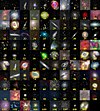NGC 5286
|
Globular cluster NGC 5286 |
|
|---|---|

|
|
| High-resolution image of the globular cluster NGC 5286, created using the Hubble Space Telescope . | |
| AladinLite | |
| Constellation | centaur |
|
Position equinox : J2000.0 , epoch : J2000.0 |
|
| Right ascension | 13 h 46 m 26.5 s |
| declination | -51 ° 22 ′ 25 ″ |
| Appearance | |
| Concentration class | V |
| Brightness (visual) | 7.4 mag |
| Angular expansion | 11.0 ' |
| Physical data | |
| distance | 35.9 kLj |
| Dimensions | 7.13 · 10 5 M ☉ |
| Age | 12.54 billion years |
| Metallicity [Fe / H] | -1.41 |
| history | |
| discovery | James Dunlop |
| Discovery date | April 29, 1826 |
| Catalog names | |
| NGC 5286 • C 1343-511 • GCl 26 • Dun 388 • GC 3642 • Caldwell 84 | |
NGC 5286 also known as Caldwell 84 , is a globular cluster located about 35,900 light years away in the constellation Centaur . The globular cluster is 4 arc minutes north of the unaided star M Centauri and was discovered by astronomer James Dunlop from Australia using his 9-inch telescope and described in his catalog from 1827. It was later included in the Caldwell and the New General Catalog , among others .
The globular cluster is about 29,000 light years away from the center of the Milky Way and is therefore in the galactic halo . It may belong to the Monoceros Ring - a star stream that is believed to have originated from a dissipated dwarf galaxy . NGC 5286, 12.54 billion years old, is one of the oldest globular clusters in the Milky Way. It is not perfectly round, but has a projected flattening of 0.12.
The speed dispersion of the stars in the center of the globular cluster is (8.1 ± 1.0) km / s . Using the star's motion, the size of the central black hole was estimated to be less than 1% of the total mass of the globular cluster; the upper limit is 6000 times the solar mass .
swell
- ↑ NASA / IPAC EXTRAGALACTIC DATABASE
- ↑ a b c SEDS : NGC 5286
- ^ A b Nathaniel EQ Paust, I. Neill Reid, Giampaolo Piotto, Antonio Aparicio, Jay Anderson, Ata Sarajedini, Luigi R. Bedin, Brian Chaboyer, Aaron Dotter, Maren Hempel, Steven Majewski, A. Marín-Franch, Antonino Milone, Alfred Rosenberg, Michael Siegel: The ACS Survey of Galactic Globular Clusters. VIII. Effects of Environment on Globular Cluster Global Mass Functions . In: The Astronomical Journal . 139, No. 2, February 2010, pp. 476-491. bibcode : 2010AJ .... 139..476P . doi : 10.1088 / 0004-6256 / 139/2/476 .
- ↑ J. Boyles, DR Lorimer, PJ Turk, R. Mnatsakanov, RS Lynch, SM Ransom, PC Freire, K. Belczynski: Young Radio Pulsars in Galactic Globular Clusters . In: The Astrophysical Journal . 742, No. 1, November 2011, p. 51. arxiv : 1108.4402 . bibcode : 2011ApJ ... 742 ... 51B . doi : 10.1088 / 0004-637X / 742/1/51 .
- ↑ a b c Duncan A. Forbes, Terry Bridges: Accreted versus in situ Milky Way globular clusters . In: Monthly Notices of the Royal Astronomical Society . 404, No. 3, May 2010, pp. 1203-1214. arxiv : 1001.4289 . bibcode : 2010MNRAS.404.1203F . doi : 10.1111 / j.1365-2966.2010.16373.x .
- ↑ Seligman
- ↑ Stephen James O'Meara: The Caldwell Objects . Cambridge University Press, 2002, p. 337.
- ↑ a b c d A. Feldmeier, N. Lützgendorf, N. Neumayer, M. Kissler-Patig, K. Gebhardt, H. Baumgardt, E. Noyola, PT de Zeeuw, B. Jalali: Indication for an intermediate-mass black hole in the globular cluster NGC 5286 from kinematics . In: Astronomy & Astrophysics . 554, June 2013, p. A63. arxiv : 1304.4176 . bibcode : 2013A & A ... 554A..63F . doi : 10.1051 / 0004-6361 / 201321168 .
